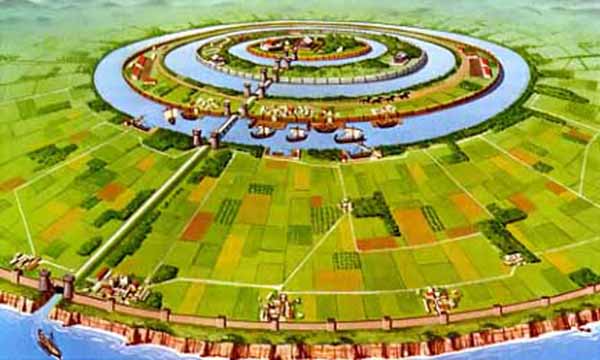
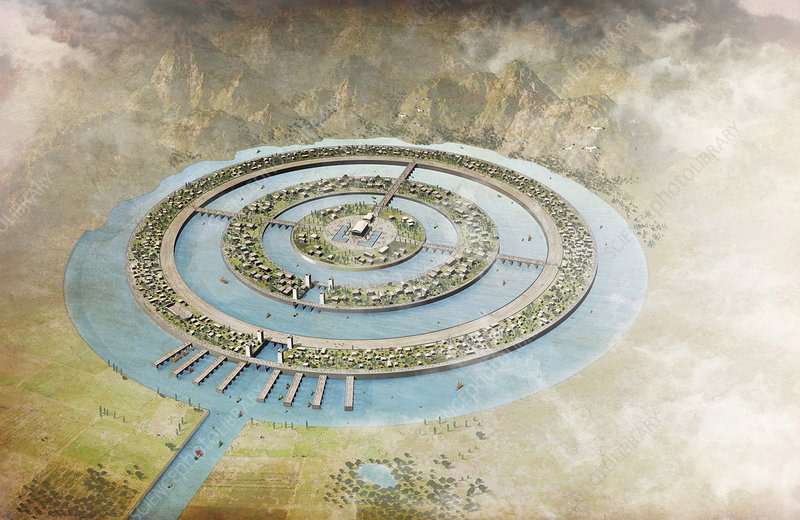


If one is to assume Atlantis actually existed - is it possible that its location was recorded in different places because it was in fact a large UFO or Mothership that changed locations?
There have been many locations proposed for the location of mythical Atlantis. Some are more or less serious attempts at legitimate scholarly or archaeological works; others have been made by psychic or other pseudoscientific means.
Many of the proposed sites share some of the characteristics of the Atlantis story (water, catastrophic end, relevant time period), but none have been proven conclusively to be the historical Atlantis.
Most of the historically proposed locations are in or near the Mediterranean Sea, either islands such as Sardinia, Crete and Santorini, Cyprus, Malta, and Ponza or as land based cities or states such as Troy, Tartessos or Tantalus (in the province of Manisa), Turkey, and the new theory of Israel-Sinai or Canaan as possible locations.
The massive Thera eruption, dated either to the 17th or the 15th century BC, caused a massive tsunami that experts hypothesize devastated the Minoan civilization on the nearby island of Crete, further leading some to believe that this may have been the catastrophe which inspired the story.
Locations as far-flung as Antarctica, Indonesia and the Caribbean have been proposed as the true site of Atlantis. The submerged island of Spartel near the Strait of Gibraltar would coincide with some elements of Plato's account, matching both the location and the date of submersion given in the Critias.

Plato (carrying Timaeus) walking with his student Socrates
Greek philosopher Plato believed in the existence of Atlantis - his version perhaps passed down from descendants of his mother's family or told to him by others he met along the way.
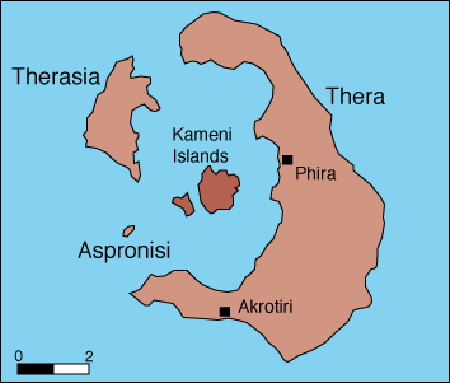
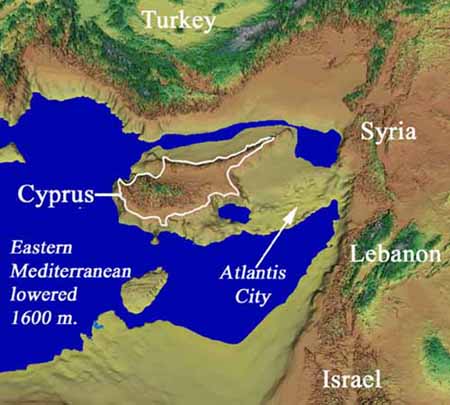

Santorini - classic Greek Thera - is an island in the southern Aegean Sea, about 200 km (120 mi) southeast of Greece's mainland. It is the largest island of a small, circular archipelago, which bears the same name and is the remnant of a volcanic caldera. It forms the southernmost member of the Cyclades group of islands, with an area of approximately 73 km2 (28 sq mi) and a 2011 census population of 15,550. The municipality of Santorini includes the inhabited islands of Santorini and Therasia, as well as the uninhabited islands of Nea Kameni, Palaia Kameni, Aspronisi and Christiana. The total land area is 90.623 km2 (34.990 sq mi).Santorini is part of the Thira regional unit.
The island was the site of one of the largest volcanic eruptions in recorded history: the Minoan eruption (sometimes called the Thera eruption), which occurred about 3,600 years ago at the height of the Minoan civilization. The eruption left a large caldera surrounded by volcanic ash deposits hundreds of metres deep. It may have led indirectly to the collapse of the Minoan civilization on the island of Crete, 110 km (68 mi) to the south, through a gigantic tsunami. Another popular theory holds that the Thera eruption is the source of the legend of Atlantis. Read more...
Among those who believe in an historical Atlantis, one common theory holds that Plato's story of the destruction of Atlantis was inspired by massive volcanic eruptions on the Mediterranean island of Santorini during Minoan times. A main criticism of this theory is that the ancient Greeks were well aware of volcanoes, and if there was a volcanic eruption, it would seem likely that it would be mentioned. Solon got his information from Egypt; if we assume that an Ancient Egyptian symbol for "hundred" was mistakenly read as "thousand", that reduces the age and size of Atlantis by a factor of a tenth, and with that alteration Atlantis fits Minoan Crete well. Many people consider this to be the likeliest theory
Off the east coast of Cyprus
Robert Sarmast, an American architect, claims to have definitely found the lost city of Atlantis on November 14, 2004, saying that by using sonar scans he was able to find manmade walls that matched the description of the structures described by Plato. The site lies 1,500m deep in the Mediterranean Sea between Cyprus and Syria.
Sardinia
In 2002 the Italian journalist Sergio Frau in his book Le colonne d'Ercole hypothesized that the Pillars of Hercules could be identified not with Gibraltar but with the Sicily Strait between Africa and Sicily, so Atlantis was really Sardinia. A catastrophic event (with a big wave) eradicated from Sardinia the ancient and still enigmatic Nuragic civilization. The few survivors migrated to the near Italian peninsula, founding the Etruscan civilization, the base for the later Roman civilization.
Malta
Dr Anton Mifsud who, with co-authors Simon Mifsud, Chris Agius Sultana and Charles Savona Ventura, published Malta Echoes of Plato's Island also added another recent theory.Their book is the product of thoughtful and profound research about the archeological sites and ancient remains related to Atlantis. Frances Galea in his book Malta Fdal Atlantis also wrote about the results of his lifelong research on several ancient studies and known theories on Atlantis, particularly that of Giorgio Grongnet, the renowned Maltese architect, who in 1854 claimed that the Maltese Islands are the remnants of Atlantis.
Near Cape Spartel
Another recent theory is based on a recreation of the geography of the Mediterranean at the time of Atlantis' supposed existence. Plato states that Atlantis was located beyond the Pillars of Hercules, the name given to the Strait of Gibraltar linking the Mediterranean to the Atlantic Ocean. 11,000 years ago the sea level in the area was some 130 metres lower, exposing a number of islands in the strait. One of these, Spartel, could have been Atlantis, though there are a number of inconsistencies with Plato's account.
Troy
The geologist Eberhard Zangger has proposed the theory that Atlantis was in fact the city state of Troy. He both agrees and disagrees with Rainer W. Kuhne: He believes too that the Trojans-Atlanteans were the sea peoples, but only a minor part of them. He proposes that all Greek speaking city states of the Aegean civilization or Mycenae constituted the sea peoples and that they destroyed each other's economies in a series of semi-fratricidal wars lasting several decades.
Tantalis
(Manisa province in Turkey)British archaeologist Peter James took a clue from Plato's mention of king Tantalus, and investigated the city of Tantalis (also Tantalos) in the province of Manisa, Turkey. In addition to having very similar sounding anagram names, numerous inscriptions and ancient writings from the region matched the Atlantis story. Tantalis, formerly a wealthy city state, was destroyed when a powerful earthquake struck and caused a lake to flood the city.
Andalucia
A theory by Juan Fernandez Amador de los Rios (1919), Jurgen Spanuth (1953), Georgeos Diaz-Montexano (2000) Atlantis Discovery, Rainer W. Kuhne (2003) suggests that the Atlanteans were the Sea Peoples who attacked the Eastern Mediterranean countries around 1200 BC. The city and state of Atlantis were located in Andalucia, 50 kilometers southwest of Seville. Recent satellite photos show two rectangular structures which may be interpreted by Werner Wickboldt (2002) and Rainer W. Kuhne (2003) as the "temple of Poseidon" and "the temple of Cleito and Poseidon".
In the area of the Black Sea at least three locations have been proposed: Bosporus, Sinop and Ancomah (a legendary place near Trabzon).
The nearby Sea of Azov was proposed as another site in 2003. Various islands or island groups in the Atlantic Ocean were also identified as possible locations, notably the Azores (Mid-Atlantic islands which are a territory of Portugal), and several Caribbean islands.
In Northern Europe, Sweden (by Olof Rudbeck in "Atland", 1672-1702), Ireland, and the North Sea have been proposed (Swedish geographer Ulf Erlingsson combines the North Sea and Ireland in a comprehensive hypothesis).
Areas in the Pacific and Indian Ocean have also been proposed including Indonesia, Malaysia or both (i.e. Sundaland) and stories of a lost continent off India named "Kumari Kandam" have drawn parallels to Atlantis. Even Cuba has been suggested.
The Canary Islands have also been identified as a possible location, west of the Straits of Gibraltar but in close proximity to the Mediterranean Sea. Some believe that Atlantis stretched from the tip of Spain to Central America.
German researchers Siegfried and Christian Schoppe locate Atlantis in the Black Sea: Before 5500 BC there was a great plain in the northwest at a former freshwater-lake. 5510 BC the barrier at today's Bosporus broke due to the rising sea level of the world-ocean. The Pillars of Hercules are identical with the Strait of Bosporus. Oreichalcos means the obsidian stone that used to be a cash-equivalent at that time and was replaced by the spondylus shell around 5500 BC. The geocatastrophic event led to the neolithic diaspora in Europe, also beginning 5500 BC.
In 2000 AD Robert Ballard in a small submarine found remains of human habitation around 300 feet underwater in the Black Sea off the north coast of Turkey. The area flooded around 5,000BC. This flood may have inspired the Biblical story of Noah's Ark; but the area need not be Atlantis.
Finnish pseudohistorian Ior Bock locates Atlantis to the southern part of Finland where he claims a small community of people lived during the Ice Age. This is a small part of a large saga that he claims to have been told in his family through the ages. Dating back to the development of language itself.
The most recent speculation is published in the book Atlantis From a Geographer's Perspective: Mapping the Fairy Land (ISBN 0975594605) by Swedish geographer Dr. Ulf Erlingsson from University of Uppsala. It proposes that Atlantis actually referred to Ireland which fits closely in geographic and landmark descriptions. Ireland has not sunk beneath the sea, but the Dogger Bank shoal was an island which sank in the North Sea about 6100 B.C. as the world sea level rose as the Ice Age icecaps melted. Some related theories place the location of Atlantis between Britain and France on the Celtic Shelf. This theory was first developed seriously by Lewis Spence and has been recently revived by some oceanographers.
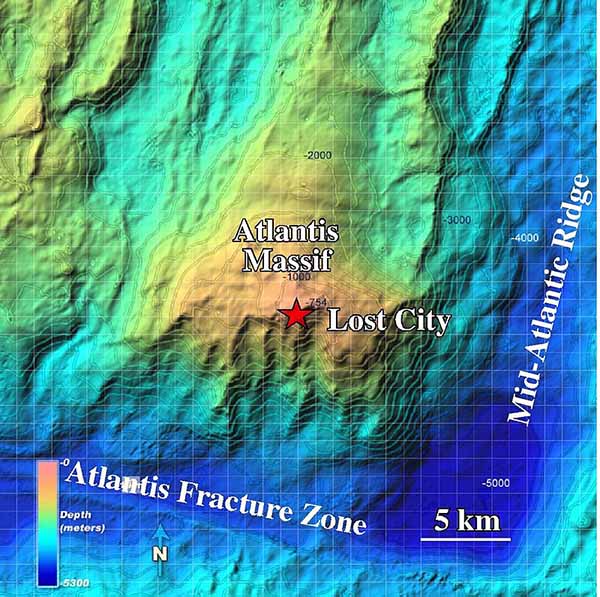
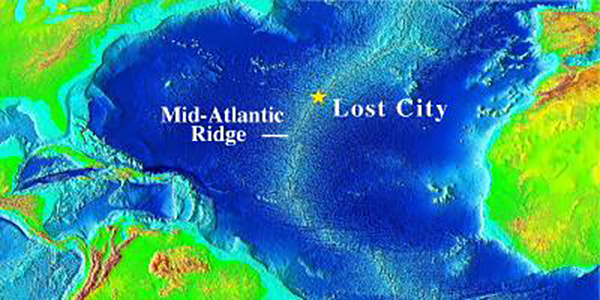
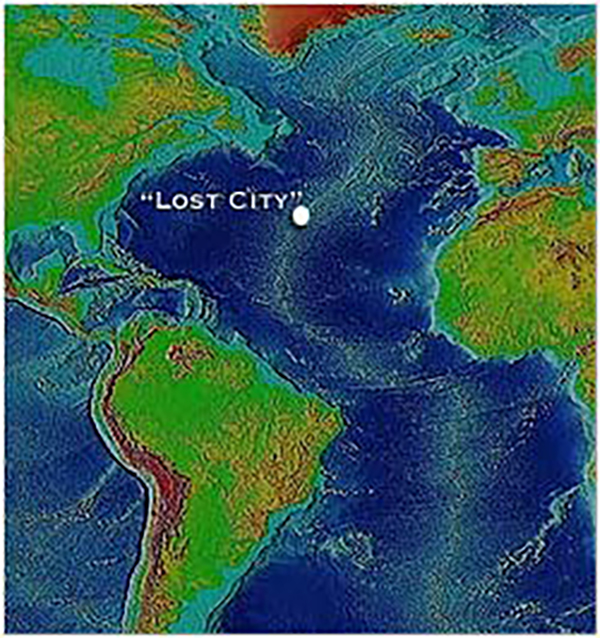
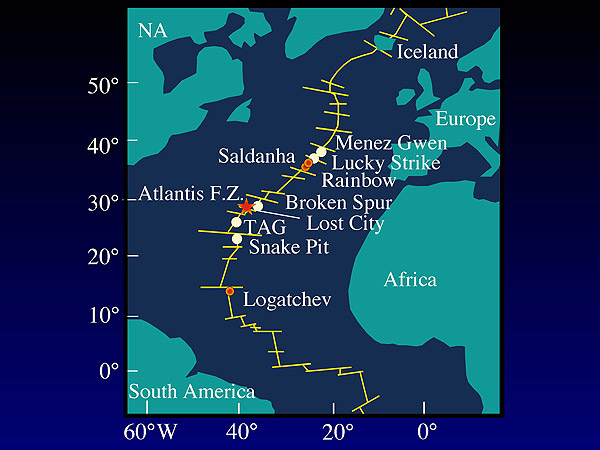
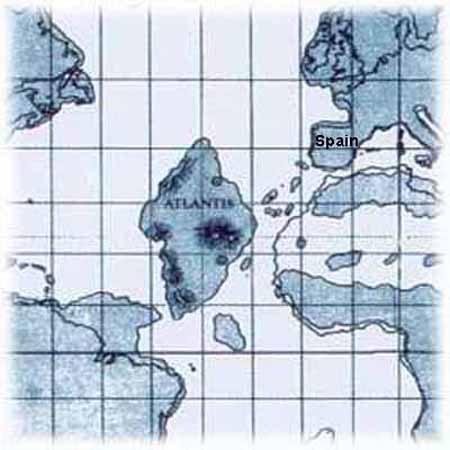
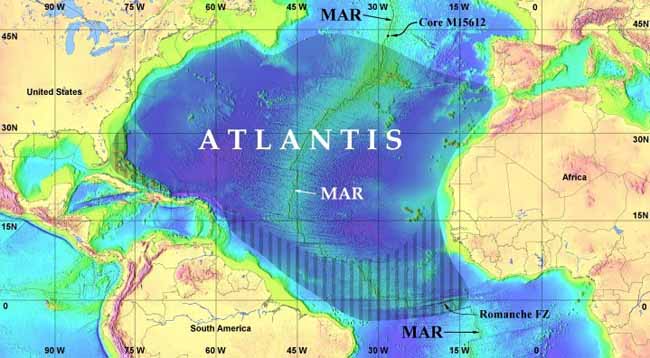
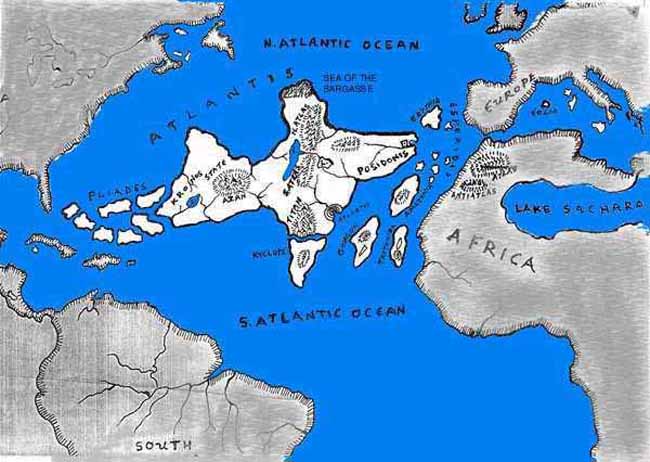
Geological studies of the mid-Atlantic fail to demonstrate that the continent of Atlantis existed there. However, the geology of the Atlantic Ocean does not exclude the possibility of a sunken island. If such an island existed it would have been much smaller than the island continent of Australia. Plato never claimed that a whole continent disappeared. He referenced a sunken island in front of another continent. One of the more likely places then would be around the Azores Islands which are a group of islands belonging to Portugal located about 900 miles (1500 km) west of the Portugese coast. Some people believe the islands could be the mountain tops of Atlantis.
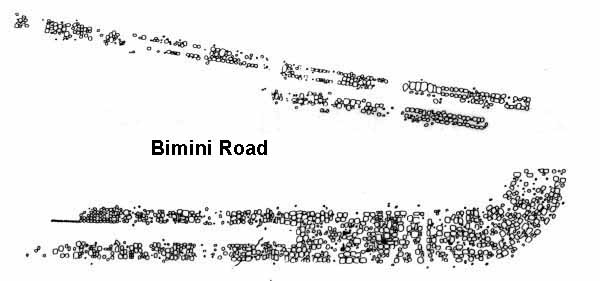
Recent underwater discoveries off the west coast of Cuba have led some to speculate on an Atlantean connection. However, even before these discoveries were announced, author Andrew Collins had explored the Cuba connection in a book titled "Gateway to Atlantis." Collins supports his hypothesis with a great deal of indirect but compelling historical and geographical evidence. He finally suggests present-day Isle of Youth and the shallow sea bottom that surrounds it as a possible location for Atlantis.
Not all geologists deny the possibility of a sunken island in Central America. After the Charles Berlitz book The Mystery of Atlantis, a Canadian Hungarian geologist-topographer's book was published, entitled Atlantis: The Seven Seals. The author, Z.A. Simon, called the attention to these controversies. He included some supporting conclusions of Dr. J. Manson Valentine, M. Dmitri Ribikoff, E. Umland and C. Umland, Robert B. Stacy-Judd, Dr. David Zink, John P. Cohane, Peter Tompkins, Pino Turolla, Captain Alexander, Francis Hitching, James Bailey, Dr. C.J. Cazeau, Dr. S.D. Scott, Brad Steiger and William R. Fix.
The June 1981 edition of Marine Geology shows some radiocarbon dates on mangrove peat, based on the estimate of Broecker and Kulp, listing dates between 5590 and 3680 BC, with connection of the gradual sinking of the Florida-Bimini region. Most recently the rate of the sea level's rise has slowed to 4.5 in (114 mm) per century. Prior to that time it was one foot per century. Near Andros Island, underwater explorer Jacques Cousteau found a huge submerged cave 165 ft (50 m) beneath the surface.
There are stalactites and stalagmites in it, that can be formed in the open air only. Marine sediments on the walls of the grotto enabled scientists to estimate its submersion around or after 10,000 BC. The submarine topography of the Bahamian region shown in the huge Russian Atlas Mira by detailed isobaths, catches the attention of a topographer. The sea floor on the northern side of Cuba, Haiti and Puerto Rico indicates a definite system of submerged valleys of ancient rivers, combined with sunken mountain ranges. The "Tongue of the Ocean" at Andros Island is undoubtedly an underwater ravine caused by terrible tectonic forces, surrounded by almost vertical walls, as a "memento" of the catastrophe. The main problem with this theory is that Atlantis was supposed to have submerged rapidly, following an earthquake.
Z.A. Simon offers an "accurate" map of Plato's rectangular island with its given dimensions as 2,000 by 3,000 stadia, overlaying its outline on the suspected ancient irregular shoreline of that traditional island in the Bahamas region. (An Attic stadium corresponds to 177.6 m)
Prof. Arysio Nunes dos Santos, Ph. D. in Nuclear Physics; Free-Docent, and Professor of Nuclear Physics at the Federal University of Minas Gerais, Brazil, has been researching on Atlantis for almost 30 years now, pointing out that "Atlantis was never found because we have all been looking in the wrong places". The reason for this, according to Prof. Santos, is that when Plato spoke of the Ocean of Atlantis, he was not speaking of the ocean that we today call Atlantic Ocean, but of the whole ocean that encircles Eurasia and Africa.
Prof. Santos hence concludes that Atlantis is really located in the Indo-Pacific Ocean, which was considered to be the eastward extension the modern Atlantic Ocean. The modern Atlantic Ocean was once deemed to extend all the way to the East Indies, a conception which lasted down to the times of Christopher Columbus and other Renaissance explorers and geographers. Despite the prevalent opinion of experts of all sorts that "continents cannot possibly sink", Prof. Santos managed to discover a whole sunken continent in the region of Indonesia, which he identifies with the Lost Continent of Atlantis, as can be seen in the detailed map published in his Atlantis site.
Prof. Santos hence concludes that Atlantis is really located in the Indo-Pacific Ocean, which was considered to be the eastward extension the modern Atlantic Ocean. The modern Atlantic Ocean was once deemed to extend all the way to the East Indies, a conception which lasted down to the times of Christopher Columbus and other Renaissance explorers and geographers. Despite the prevalent opinion of experts of all sorts that "continents cannot possibly sink", Prof. Santos managed to discover a whole sunken continent in the region of Indonesia, which he identifies with the Lost Continent of Atlantis, as can be seen in the detailed map published in his Atlantis site.
In February 2005, Canberra-based independent researcher Raimy Che-Ross, announced to the world that he had found a lost city in the unsunken Malaysian portion of the lost continent. A well funded expedition is now underway involving a large ground team of experts and Malaysia Centre For Remote Sensing (Macres) satellites. The Malaysian Department of Museums and Antiquities has been instructed to report their findings by August 2005.
In South India and Sri Lanka there is a reputed "Kumari Kandam" (kandam means "continent" in Tamil), believed to be submerged under the sea. This continent is surrounded by legendary stories similar to those of Atlantis. It has been called the "cradle of Dravidians". Also, there has been some people linking the "Kumari continent" to Lemuria.
In the Gulf of Cambay, there is an archeological submarine site of a former island named Dwaraka, which is mainly associated with locations in Indian mythology (especially in the Mahabharata), which has also appeared in discussions about Atlantis. But its date (about 1,500 BC) is too recent to correspond to the real site of Atlantis, according to Plato's date of 9,600 BC.
A seemingly bizarre hypothesis that the city of Atlantis was in Antarctica has typically received incredulous reactions from the scientific community. Under this theory, all continents and oceans shifted as one, causing the ancient south pole to be over ocean, liberating a considerable portion of Antarctica from its current ice sheet, yielding ideal conditions for human habitation. To back up this theory, controversial claims of precipitation-ice sheet thickness mismatches; new methods of translating Plato's text; and native flood stories from all sorts of different cultures around the world back up this controversial claim. However, due to the nature of finding and then excavating sites in Antarctica, not much followup research is immediately possible with such limited funding given public awareness of this hypothesis. Also, it is questionable that such a widespread ecological catastrophe in the form of an extreme geologic process could occur in such a short time period and leave relatively little evidence.
Ponza has many similarities to the Atlantis legend. Legend say that Ponza was the lost island of Tyrhenia which was large and had a city at it's edge. It was connected by land to the Italian mainland near Naples (Napoli). A volcano exploded and the island sunk leaving only the mountain top which is now called Ponza. Near Naples is Pozzuoli where Roman Temples in the harbor rose above water in the late 1960's due to volcanic processes.
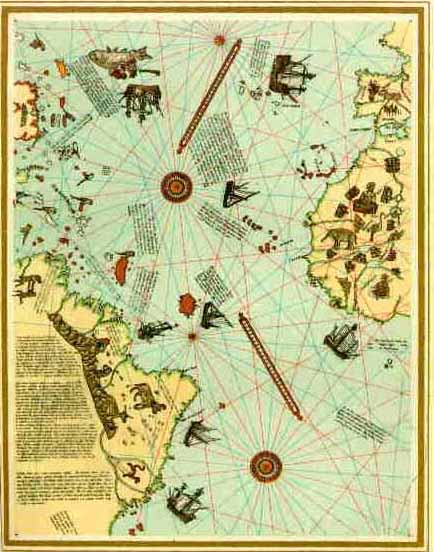
The Piri Reis Map implies Atlantis was located in Antarctica and that the map could only have been made with knowledge of how the Earth looks from a high altitude.
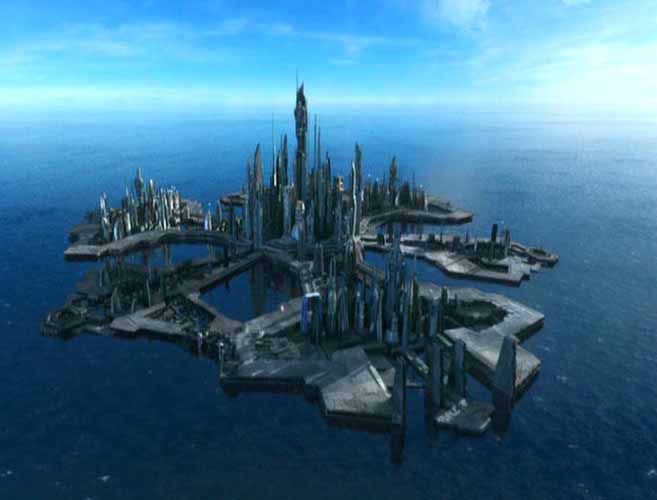
In Stargate Atlantis, taken place at the end of season 7 of Stargate SG-1 (The Lost City), the SGC finds out that the city known as Atlantis was a city of technology and science, which left the planet for another galaxy, the Pegasus Galaxy. Under the command of Doctor Elizabeth Weir, she and her expedition team set out to explore and find this city and if there are any Ancients remaining, learning that there are none. They venture off to find a new energy source within the Pegasus Galaxy for the trip back to Earth, only to encounter an alien race which defeated the powerful Ancients, known as The Wraith.
Atlantis has also been the subject of such films as the 1961 Atlantis, the Lost Continent, Disney's 2001 animated feature Atlantis: The Lost Empire, Gainax's Anime series Nadia: The Secret of Blue Water, the French film Atlantis by Luc Besson (1991) - in fact an underwater wildlife documentary, the Stargate SG-1 TV show spin-off Stargate Atlantis, the book Atlantis Found by Clive Cussler and many others. A complete listing of the appearances of Atlantis in modern media would be too extensive to include here. Jules Verne's classic 20,000 Leagues Under The Sea also included a visit to sunken Atlantis aboard Captain Nemo's submarine Nautilus. One film set in times before Classical Greece arose shows shipwrecked Greek sailors in the Atlantic being rescued by a modern-looking submarine which was based on Atlantis.
In the DC universe, both Aquaman and Lori Lemaris - among others - were said to have come from a sunken Atlantis.
In Lori Lemaris's case, her people survived by becoming mermaids and mermen.
In the Marvel Universe, the people live in a similar manner, as blue-skinned water breathers with Prince Namor the Sub-Mariner as their ruler.
In the book Celestial Matters, the Hellenistic civilization calls Amerindians "Atlanteans".
In the role-playing game Rifts, Atlantis is a continent in the Atlantic west of the Caribbean that rises back out of the sea in the far future. Besides the fairylike Atlanteans, Rifts' Atlantis is peopled by alien colonists called the Splugorth, who enslave humans for sale on interdimensional markets.
Atlantis was also the subject of the PC-based Adventure game, Indiana Jones and the Fate of Atlantis, published by LucasArts. In the game, Indiana races the Nazis to find Atlantis and to stop them from discovering the secrets of orichalcum.
In the videogame Tomb Raider, adventurer and treasure hunter Lara Croft's quest ultimately leads her to the buried ruins of Atlantis. Her employer turns out to be an Atlantean herself, having been imprisoned for the past 10,000 years in suspended animation and now seeking to reclaim the powers of her people for her own benefit.
In the Pendragon Cycle series of books, the survivors of Atlantis ("fairies") journey to Britain where, among other places, they settle in Lyonesse and Avalon. Morgan le Fay, the Lady of the Lake, and the Fisher King are all Atlanteans, and Merlin is the son of an Atlantean princess and a Celtic Druid.
ANCIENT AND LOST CIVILIZATIONS